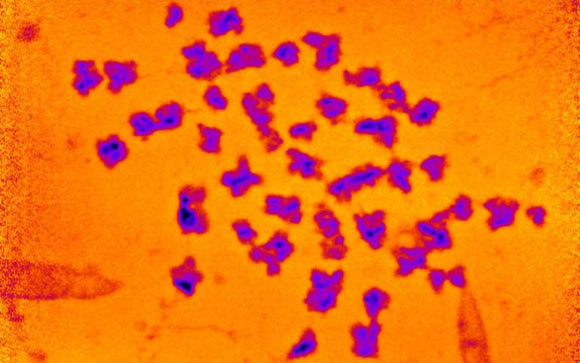Each human cell, at metaphase, normally contains 23 pairs of chromosomes, or 46 in total. Within these are four copies of 3.5 billion base pairs of DNA. In a new study, a team of scientists from the United Kingdom and the United States used a method called phase-sensitive X-ray ptychography to determine the number of electrons in a spread of all 46 human chromosomes; they found that the chromosomes were about 20 times heavier than the DNA they contained — a much larger mass than previously expected, suggesting there might be missing components yet to be discovered.
“Chromosomes have been investigated by scientists for 130 years but there are still parts of these complex structures that are poorly understood,” said Professor Ian Robinson, a researcher in the London Centre for Nanotechnology at University College London and the Condensed Matter Physics and Materials Science Division at Brookhaven National Lab.
“The mass of DNA we know from the Human Genome Project, but this is the first time we have been able to precisely measure the masses of chromosomes that include this DNA.”
“A better understanding of chromosomes may have important implications for human health,” said Archana Bhartiya, a Ph.D. student in the London Centre for Nanotechnology at University College London.
“A vast amount of study of chromosomes is undertaken in medical labs to diagnose cancer from patient samples. Any improvements in our abilities to image chromosomes would therefore be highly valuable.”
In the study, Professor Robinson, Bhartiya and their colleagues used X-ray ptychography — which involves stitching together the diffraction patterns that occur as the X-ray beam passes through the chromosomes — to create a highly sensitive 3D reconstruction.
The fine resolution was possible as the beam deployed at the UK’s Diamond Light Source was billions of times brighter than the Sun.
The chromosomes were imaged in metaphase, just before they were about to divide into two daughter cells.
This is when packaging proteins wind up the DNA into very compact, precise structures.
“Our measurement suggests the 46 chromosomes in each of our cells weigh 242 picograms (trillionths of a gram),” Professor Robinson said.
“This is heavier than we would expect, and, if replicated, points to unexplained excess mass in chromosomes.”
The results were published in the journal Chromosome Research.
_____
A. Bhartiya et al. 2021. X-ray Ptychography Imaging of Human Chromosomes After Low-dose Irradiation. Chromosome Res 29, 107-126; doi: 10.1007/s10577-021-09660-7








